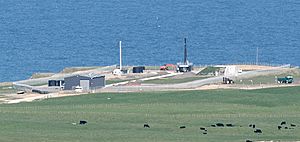Rocket Lab Launch Complex 1 facts for kids

Launch Complex 1 on Mahia Peninsula
|
|||||||||||||||||||||
| Location | Mahia Peninsula, New Zealand | ||||||||||||||||||||
|---|---|---|---|---|---|---|---|---|---|---|---|---|---|---|---|---|---|---|---|---|---|
| Coordinates | 39°15′41″S 177°51′54″E / 39.261500°S 177.864876°E | ||||||||||||||||||||
| Time zone | UTC+12 (NZST) | ||||||||||||||||||||
|
• Summer (DST)
|
UTC+13 (NZDT) | ||||||||||||||||||||
| Operator | Rocket Lab | ||||||||||||||||||||
| Launch pad(s) | 1 (1 Under construction) | ||||||||||||||||||||
|
|||||||||||||||||||||
Rocket Lab Launch Complex 1 is a special place where rockets blast off into space! It's also called the Mahia Launch Complex or Spaceport. This spaceport is found on the Mahia Peninsula in New Zealand.
It's owned and run by a company called Rocket Lab. They use this site to launch their Electron rockets. These rockets carry small satellites called CubeSats into orbit. The spaceport officially opened on September 26, 2016.
On May 25, 2017, it became the first private spaceport to try an orbital launch. Then, on January 21, 2018, it made history again. It was the first private spaceport to successfully send a rocket into orbit!
Contents
Where is Rocket Lab Launch Complex 1?
This spaceport is located at the very southern tip of New Zealand's Mahia Peninsula. This area is part of the Hawke's Bay Region on the North Island's east coast.
The launch site is on a raised flat area. It has cliffs on three sides and is about 104 meters (341 feet) high. There's only one road to get there, which connects to the main highway. The closest town, Wairoa, is about 50 kilometers (31 miles) away.
What's at the Spaceport?
Launch Complex 1 has a strong launch platform and a tall tower. This platform can hold up to 50 tons! There's also a hangar where the Electron rockets are kept. Big tanks store the fuel needed for the rockets, like liquid oxygen and kerosene.
When rockets are launched, a safety zone is created. This zone is about 8 kilometers (5 miles) around the launch pad. This helps keep everyone safe during liftoff.
How the Spaceport Started
Choosing the Best Spot
Rocket Lab first thought about building their launch site at Kaitorete Spit in New Zealand's South Island. This spot would have been good for launching satellites into a special path called a Sun-synchronous orbit. It was also close to where they wanted to build their rocket factory.
However, in August 2015, the Mahia Peninsula site was also considered. Rocket Lab officials had visited it earlier and liked it. They started working to get permission to build there. The local councils quickly approved their plans.
Why Mahia Peninsula Was Chosen
On November 23, 2015, Rocket Lab decided that the Mahia Peninsula would be their main launch site. This was because it was taking too long to get all the permissions for the Kaitorete Spit location.
The Mahia site was better for launching rockets often. It also had less air traffic, which made it easier to get rockets into space. The Mahia site is allowed to launch a rocket every 72 hours for 30 years! Rocket Lab thinks they might launch about once a week.
Rocket Lab started building at Mahia in December 2015. By June 2016, most of the main work was done. Roads were improved, and internet services were set up. They also worked with Airways New Zealand to make sure flights could happen safely.
The Rocket Lab Launch Complex 1 officially opened on September 26, 2016. Important people, including government officials and local landowners, attended the ceremony.
Rocket Launches from Mahia
Pad A: LC-1A
The first test flight of the Electron rocket, called "It's a Test," happened on May 25, 2017. The rocket lifted off successfully from Launch Complex 1. However, it didn't quite reach its planned orbit.
The second launch from this pad was on January 21, 2018. This time, the Electron rocket, named "Still Testing," successfully made it to orbit! It carried satellites for different companies, including Planet Labs and Spire Global. It also carried a special object called the Humanity Star.
Pad B: LC-1B
To launch even more rockets, Rocket Lab started building a second launch pad at LC-1. This new pad is called LC-1B. Construction began on December 19, 2019. It is expected to be finished soon, allowing Rocket Lab to launch more missions into space!

